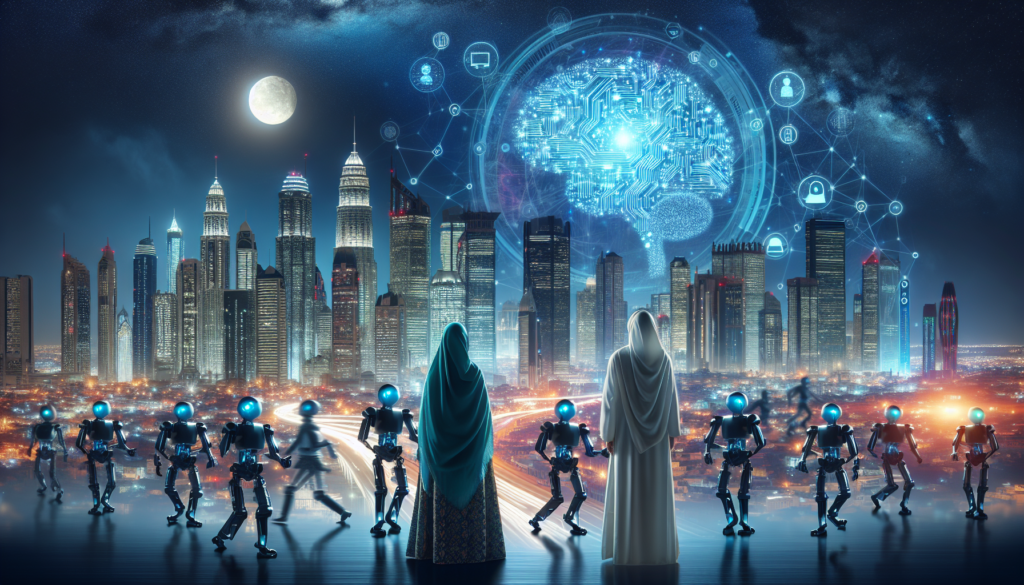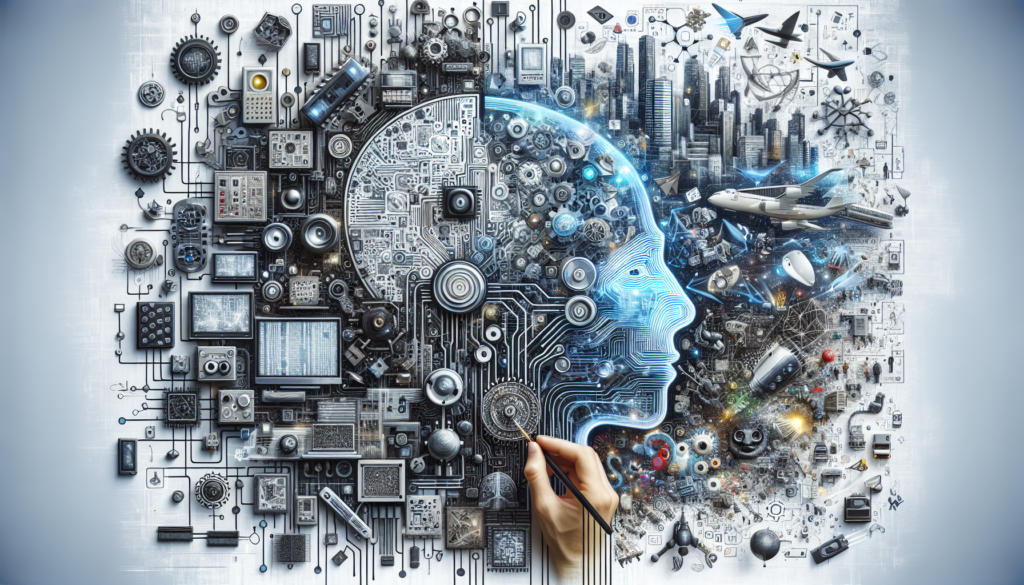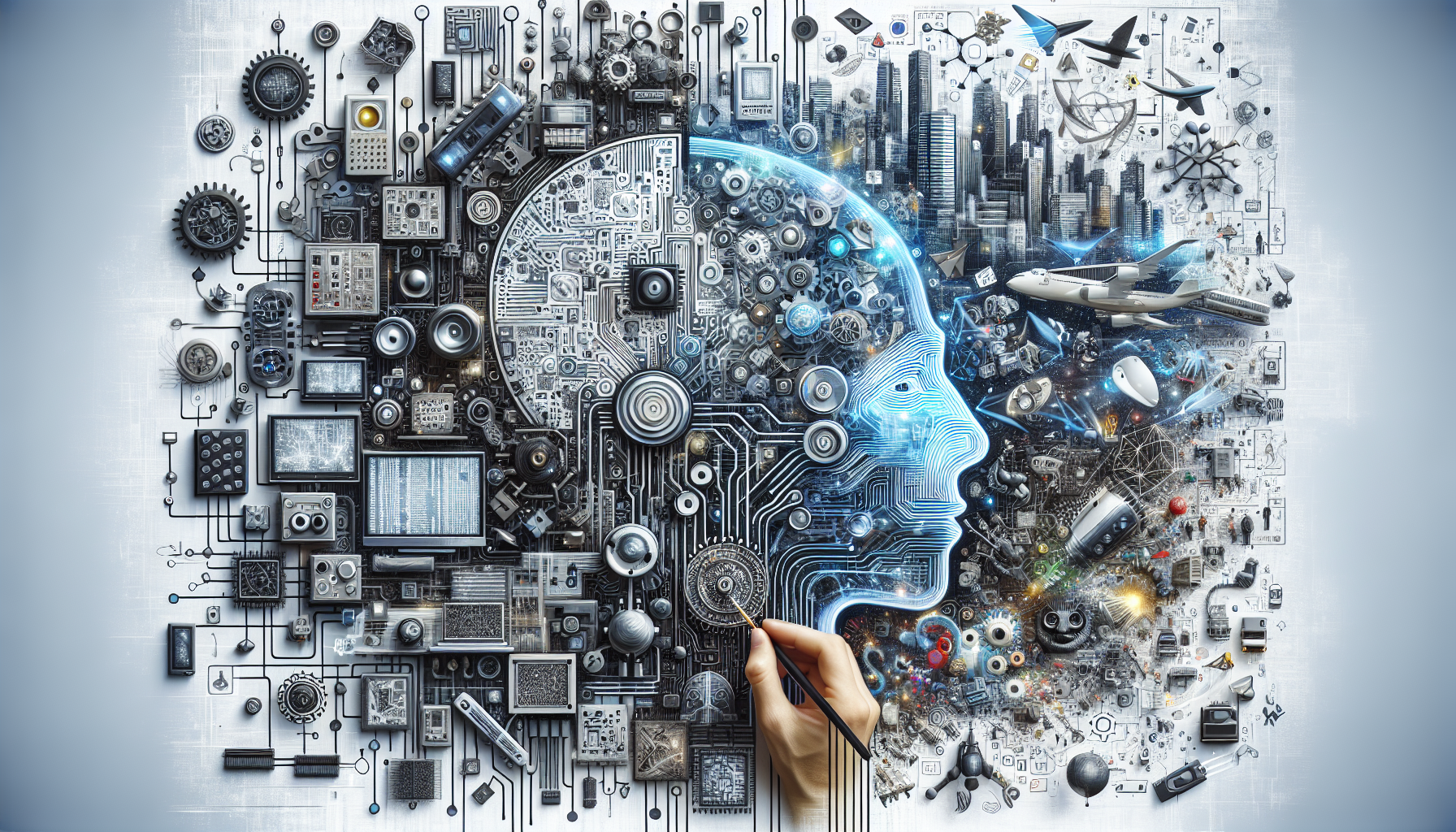Imagine a world where machines possess the ability to think, learn, and problem-solve just like humans. Intriguing, isn’t it? In this captivating article titled “A Simple Explanation of AI,” you will uncover the fascinating world of Artificial Intelligence (AI) and gain a clearer understanding of what it truly is. Explore the basic concepts and principles behind AI technology as we demystify this complex subject in a friendly and accessible manner. Get ready to embark on a journey that will unravel the mysteries behind AI and leave you with a newfound appreciation for the incredible potential it holds.
Defining AI
Overview of AI
Artificial Intelligence (AI) refers to the simulation of human intelligence in machines that are programmed to think and learn like humans. It is a technology that enables computers to perform tasks that would typically require human intelligence, such as visual perception, speech recognition, decision-making, and problem-solving. AI is a rapidly evolving field that has the potential to revolutionize various industries and affect our daily lives in significant ways.
The concept of intelligent machines
At the heart of AI is the idea of creating intelligent machines that can mimic human intelligence. These intelligent machines are designed to perceive their environment, understand and interpret information, learn from experience, and make informed decisions or take appropriate actions. The goal is to develop machines that can exhibit traits like reasoning, problem-solving, language understanding, and even creativity.
Understanding artificial intelligence
AI can be categorized into two main types: Narrow AI and General AI. Narrow AI refers to AI systems that are designed to perform specific tasks or solve particular problems. These systems are highly specialized and focused on a specific domain, such as image recognition or speech synthesis. On the other hand, General AI refers to AI systems that possess the ability to understand, learn, and apply knowledge across a wide range of tasks or domains, just like a human being.
The goal of AI
The ultimate goal of AI is to develop machines that can match or surpass human intelligence across all cognitive tasks. This concept is often referred to as Superintelligent AI. While Superintelligent AI remains a topic of theoretical discussion, current advancements in AI have brought significant improvements in various domains. The primary goal of AI is to make machines more efficient, accurate, and capable of autonomous decision-making, ultimately enhancing the quality of human life.
Types of AI
Narrow AI
Narrow AI, also known as Weak AI, is designed to excel in a specific area or perform a particular task. These AI systems are created with a narrow focus and are not capable of performing tasks outside of their designated scope. Examples of Narrow AI include voice assistants like Amazon’s Alexa and Apple’s Siri, email spam filters, and recommendation algorithms used by online platforms.
General AI
General AI, also known as Strong AI, refers to AI systems that possess the ability to understand, learn, and apply knowledge across various domains or tasks. These systems aim to replicate human-like intelligence and are capable of reasoning, problem-solving, and adapting to new situations. General AI would be able to perform intellectual tasks that any human being can do. However, achieving General AI is still a significant challenge and remains an area of active research.
Superintelligent AI
Superintelligent AI refers to AI systems that surpass human intelligence across all cognitive tasks. This concept explores the idea of creating machines that are not only capable of matching human intelligence but also significantly surpassing it. Superintelligent AI would possess advanced abilities in areas such as problem-solving, learning, and decision-making. While Superintelligent AI remains largely theoretical, some experts believe that it has the potential to reshape various aspects of society and civilization.

Machine Learning
Introduction to machine learning
Machine Learning (ML) is a subfield of AI that focuses on the development of algorithms and models that allow computers to learn and make predictions or decisions without explicit programming. ML algorithms learn from data and improve their performance over time through experience. This process involves training the algorithm on a dataset, allowing it to identify patterns, and using this knowledge to make accurate predictions or decisions.
Supervised learning
Supervised learning is a machine learning technique where the algorithm is provided with labeled training data, meaning the input data points are associated with corresponding output values. The algorithm uses this labeled data to learn patterns and relationships between the input and output variables. Once trained, the algorithm can make predictions or decisions on new, unseen data based on the learned patterns.
Unsupervised learning
Unsupervised learning is a machine learning technique where the algorithm is provided with unlabeled data, meaning there are no predefined output values. The algorithm learns from the inherent structure or patterns in the data to form its own representations or clusters. Unsupervised learning is useful for tasks such as clustering data points, discovering hidden patterns, or reducing the dimensionality of data.
Reinforcement learning
Reinforcement learning involves training an agent to interact with an environment and learn optimal actions through a trial-and-error process. The agent receives feedback in the form of rewards or penalties based on its actions, which helps it learn to maximize rewards and minimize penalties over time. Reinforcement learning is commonly used in tasks such as game-playing agents, robotics, and autonomous vehicles.
Deep Learning
Explaining deep learning
Deep Learning is a subset of machine learning that focuses on training artificial neural networks to learn directly from raw data. It aims to emulate the structure and function of the human brain by using interconnected layers of artificial neurons called neural networks. Deep Learning has gained significant popularity in recent years due to its ability to handle complex and large-scale datasets and its remarkable performance in tasks such as image and speech recognition.
Neural networks
Neural networks are the building blocks of deep learning models. They consist of interconnected artificial neurons arranged in layers, where each neuron receives input signals, performs a computation, and generates an output signal. These signals propagate through the layers, allowing the network to learn hierarchical representations of the data and make predictions or decisions.
Deep learning applications
Deep learning has found applications in various domains, including computer vision, natural language processing, speech recognition, and recommendation systems. In computer vision, deep learning models have been able to achieve remarkable accuracy in tasks such as image recognition, object detection, and facial recognition. In natural language processing, deep learning models have demonstrated impressive capabilities in tasks such as language translation, sentiment analysis, and text generation.

Natural Language Processing
Overview of natural language processing
Natural Language Processing (NLP) is a branch of AI that focuses on enabling computers to understand, interpret, and generate human language. It involves the development of algorithms and techniques that allow machines to process and analyze text and speech data. NLP has become increasingly important in the era of big data, where vast amounts of textual information are generated and require automated processing.
Text analysis
Text analysis involves using NLP techniques to extract meaningful information from textual data. This can include tasks such as sentiment analysis, entity recognition, topic modeling, and text classification. Text analysis enables machines to understand the context, sentiment, and main themes of a given piece of text, which can be useful for various applications such as customer feedback analysis, market research, and content recommendation.
Speech recognition
Speech recognition, also known as Automatic Speech Recognition (ASR), is the process of converting spoken language into written text. NLP techniques are employed to understand and transcribe spoken words accurately. This technology is used in applications like voice assistants, transcription services, and hands-free operation of devices.
Language translation
Language translation involves using NLP techniques to automatically translate text or speech from one language to another. Machine translation systems leverage large-scale multilingual datasets and neural networks to generate accurate and fluent translations. Language translation has become an essential tool for breaking language barriers, enabling global communication, and facilitating cross-cultural understanding.
Computer Vision
Understanding computer vision
Computer Vision is a field of AI that focuses on enabling machines to understand and interpret visual information from images or videos. It involves developing algorithms and models that can extract meaningful information from visual data and perform tasks such as image recognition, object detection, and image generation. Computer Vision has a wide range of applications, from autonomous vehicles to surveillance systems.
Image recognition
Image recognition is a computer vision task that involves identifying and classifying objects or patterns within an image. By using deep learning techniques, computer vision models can learn to recognize specific objects or even detect more complex scenes. Image recognition has applications in various fields, such as medical imaging, autonomous navigation, and quality control in manufacturing.
Object detection
Object detection is a computer vision task that involves locating and classifying multiple objects within an image or video. This task goes beyond image recognition by not only identifying objects but also providing their precise locations. Object detection is crucial in applications such as autonomous driving, surveillance, and augmented reality.
Facial recognition
Facial recognition is a computer vision technique that involves identifying and verifying an individual’s identity based on their facial features. This technology uses algorithms to analyze facial patterns and compare them to a database of known faces. Facial recognition has applications in areas like security systems, access control, and digital identity verification.
Robotics
AI and robotics integration
The integration of AI and robotics aims to create intelligent machines that can autonomously perceive their environment, make decisions, and perform physical tasks. By combining AI techniques such as machine learning and computer vision with robotics hardware, it becomes possible to develop robotic systems capable of interacting with the world and performing complex tasks with precision.
Autonomous robots
Autonomous robots are robotic systems that can operate independently without human intervention. These robots leverage AI technologies like machine learning and sensor fusion to perceive their surroundings, make decisions, and execute actions based on their programmed objectives. Autonomous robots have applications in various fields, such as self-driving cars, delivery drones, and industrial automation.
Robotic process automation
Robotic process automation (RPA) involves the use of software robots, also known as bots, to automate repetitive and rule-based tasks within business processes. RPA systems can mimic human interactions with computer systems, enabling them to perform tasks like data entry, document processing, and data extraction. These systems utilize AI techniques like machine learning and natural language processing to understand and process data.
Ethics and AI
The ethical implications of AI
As AI continues to advance, there are important ethical considerations that need to be addressed. AI systems have the potential to impact privacy, security, and human rights, among other areas. Key ethical concerns include transparency and accountability of AI systems, fairness and bias in decision-making algorithms, and the potential for job displacement. It is crucial to ensure that AI is developed and used in a way that aligns with ethical values and respects human dignity.
AI bias
AI bias refers to the unfair or discriminatory outcomes that may arise from biased data or biased algorithms in AI systems. Biases can occur if the training data used to build AI models is unrepresentative or if the algorithms themselves have inherent biases. Addressing AI bias requires careful selection and preprocessing of training data, rigorous testing and validation of algorithms, and ongoing monitoring and improvement of AI systems.
Privacy concerns
AI systems often require access to large amounts of data to perform effectively. This raises concerns about the privacy and security of personal or sensitive information. Safeguarding privacy in AI involves implementing strong data protection measures, obtaining informed consent from users, and ensuring data anonymization or aggregation whenever possible. Additionally, regulations such as the General Data Protection Regulation (GDPR) in Europe aim to provide individuals with control over their personal data and establish guidelines for AI applications.
Job displacement
The increasing automation and adoption of AI technologies raise concerns about the potential displacement of human workers. Certain tasks and jobs may become obsolete as AI systems can perform them more efficiently and accurately. It is important to consider the social and economic impact of AI on the workforce and explore opportunities to upskill or transition workers to new roles. Collaboration between AI systems and humans, known as augmented intelligence, can also lead to new job opportunities and improve productivity.
AI in Everyday Life
AI in smartphones
AI has become an integral part of smartphones, enhancing various features and functionalities. Virtual assistants like Apple’s Siri, Google Assistant, and Samsung’s Bixby utilize AI algorithms and natural language processing to understand and respond to user queries, manage appointments, provide recommendations, and perform tasks such as sending messages or playing music. AI also powers features like facial recognition for unlocking phones and optimizing battery life based on usage patterns.
AI in virtual assistants
Virtual assistants are AI-powered applications that can provide personalized assistance and perform tasks based on voice commands or text inputs. These assistants can help with tasks such as scheduling appointments, setting reminders, ordering products, or providing information. Popular virtual assistants include Amazon’s Alexa, Microsoft’s Cortana, and Apple’s Siri. AI enables these virtual assistants to understand natural language, learn user preferences, and continuously improve performance.
AI in healthcare
AI has the potential to revolutionize healthcare by enabling more accurate diagnoses, personalized treatment plans, and improved patient outcomes. Machine learning algorithms can analyze medical data such as imaging scans, electronic health records, and genomic data to identify patterns and make predictions. AI systems can also assist in drug discovery, robotic surgeries, remote patient monitoring, and telemedicine. The integration of AI in healthcare aims to improve efficiency, reduce costs, and enhance patient care.
AI in transportation
AI has transformed the transportation industry, enabling advancements in autonomous vehicles, smart traffic management systems, and ride-sharing platforms. Self-driving cars leverage AI technologies such as computer vision, sensor fusion, and machine learning to perceive the environment, make real-time decisions, and navigate safely. AI-powered traffic management systems can optimize traffic flow, reduce congestion, and enhance safety. Ride-sharing platforms utilize AI algorithms to match passengers with drivers and optimize routing for efficient transportation.
Future of AI
Predictions for AI advancements
The future of AI holds immense potential for further advancements and impactful applications. As technology continues to progress, AI is expected to become more sophisticated, efficient, and integrated into various aspects of our lives. Predictions for AI advancements include the development of more powerful hardware architectures, breakthroughs in natural language understanding, advancements in robotics, and the increased adoption of AI in sectors such as finance, education, and entertainment.
AI in space exploration
AI is already playing a significant role in space exploration, and its importance is likely to increase in the future. AI systems can assist in activities such as satellite communications, autonomous navigation, and data analysis from space missions. AI is also being utilized to develop autonomous robots for space exploration and to analyze vast amounts of astronomical data. The integration of AI in space exploration can enhance the efficiency and success of missions while reducing the risk to human astronauts.
AI and the future of work
The impact of AI on the future of work is a topic of great interest and discussion. While AI has the potential to automate certain tasks and jobs, it can also create new opportunities and transform existing roles. The future of work is likely to involve a collaboration between humans and AI systems, where AI augments human capabilities and frees up time for more complex and creative tasks. It is crucial for individuals and organizations to adapt to this evolving landscape by acquiring new skills and embracing lifelong learning.
In conclusion, AI is a rapidly evolving field that encompasses various technologies and techniques aimed at mimicking human intelligence in machines. From Narrow AI to General AI, from machine learning to deep learning, and from computer vision to robotics, AI has transformative potential across multiple domains. However, it is essential to consider the ethical implications, address biases, ensure privacy, and explore the social and economic impact of AI. As AI continues to advance, it is poised to shape our everyday lives, drive innovation, and play a crucial role in shaping the future.
